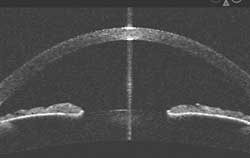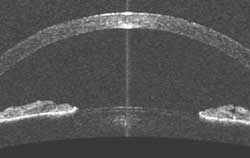AIGS consensus recommends gonioscopy in every eye exam
|
|
Gonioscopy should become a standard part of the ophthalmic examination, according to a consensus of the Association of International Glaucoma Societies (AIGS) discussed at a meeting on angle closure glaucoma last year.
Consensus meetings and their intended reports are developed with experts from around the world reviewing the literature. The goal of a consensus meeting is to use expert experience along with published literature to understand what is known and what needs to be known.
The purpose of this AIGS meeting was to develop a consensus on the mechanisms related to the development of angle closure glaucoma as well as enhanced screening and treatment strategies.
Gonioscopy underused
|
Images: Fingeret M |
Gonioscopy is crucial to establishing the diagnosis of primary angle closure glaucoma (PACG) and yet is an underperformed test.
Part of the gonioscopic examination includes determining the presence of iridotrabecular contact. If it is present, then indentation is needed to describe whether it is appositional or synechial (permanent). The documentation should include the number of degrees of contact.
A relatively new type of lens, the magnifying Goldmann lens, may be useful in identifying angle features and abnormalities. Still, this lens will not substitute for the four-mirror goniolens, which is needed to indent the eye when observing for iridotrabecular contact.
In regard to documentation, it is recommended that gonioscopic findings be recorded in “clear text.” Clinicians have used different cross-like patterns with abbreviations as well as different classification systems, which have led to confusing situations. One approach is to document the structures seen, angle width, pigmentation and iris contour in the chart.
When performing gonioscopy, it is important that adequate anesthesia be used, the room is dark and a small narrow beam be kept away from the pupil. Lens tilting should be minimized, because even minor movements can allow one to see over a convex iris, enabling a narrow angle to appear open.
High magnification is often needed to identify the termination of the corneal wedge, which represents the anterior edge of the trabecular meshwork (TM). Determine whether the iris is in contact with the TM, perform gonioscopy for the entire circumference and then perform an indentation exam. The best lens to use is open to debate, with some preferring Goldmann-style lenses and others a four-mirror lens.
PACG impact underestimated in West
Most clinicians in Western countries do not fully understand the effect of angle closure glaucoma on much of the world. Primary angle closure glaucoma (PACG) is a common cause of blindness in Asia and is probably underreported in Western countries.
While primary open angle glaucoma (POAG) is more common in Western countries, half of all blindness is caused by PACG due to its severity. With aging populations living longer, it is anticipated that PACG will become a more common clinical problem. Also as globalization occurs, Asian populations are living in most parts of the world.
By the year 2010, it is estimated that 4 million individuals will have POAG, and 15 million will have PACG. The numbers will increase to 60 million and 20 million, respectively, by the year 2020. Significantly, the number of individuals blind will rise, so that by the year 2020, 5.9 million will be impaired due to POAG and 5.3 million will be impaired due to PACG.
Therefore, despite the fact that there are three times more cases of POAG than PACG, the number of cases of blindness is about equal between the two conditions. Interestingly, PACG most commonly occurs as an asymptomatic disease.
Anterior segment imaging
A great deal has been learned over the past 2 decades in regard to PACG. The ultrasound biomicroscope (UBM) was introduced 15 years ago and allowed a cross-sectional view of the anterior chamber angle in real time. From this vantage point, a better understanding of the mechanisms and management occurred.
A new technology, the anterior segment imaging device, has recently been introduced, replacing the UBM. Two companies have an anterior chamber optical coherence tomographer: Carl Zeiss Meditec (Dublin, Calif.) with the Visante, and Heidelberg Engineering (Vista, Calif.). These instruments allow even better views of the anterior chamber angle, improving diagnosis without the need to touch the eye.
Unfortunately, the cost of these instruments may preclude them from being used as affordable screening tests.
Screening criteria, tools, tests
Screening for individuals at risk for developing angle closure glaucoma should be performed in all those who are 40 years and older undergoing an eye examination. Most optometrists perform this type of screening using the van Herick test, which evaluates anterior chamber limbal depth (ACLD) with the slit lamp. The van Herick test is primarily performed to assess whether the angle will allow for safe dilation, with a risk assessment for angle closure glaucoma as a secondary result.
If an eye fails the van Herick test, gonioscopy should be performed, because individuals may have shallow limbal depths and open angles.
The risks for a person with a positive van Herick (shallow ACLD) and open angle for developing acute angle closure (AAC) are not clear. Also, what happens to those who are examined, but never dilated? Is the van Herick test still performed as part of the slit lamp examination? Do optometrists recognize the need to screen for narrow angles even when they do not dilate?
Instruments that allow for an undilated retinal exam exist in many offices. It is hoped that patients who undergo these tests are still having their ACLD evaluated and, when it is shallow, further testing is being performed even when dilation is not.
It is important for clinicians to recognize that failure of the ACLD or van Herick test does not indicate the presence of an angle capable of closing. Rather as a screening test, it indicates the need for a gonioscopic exam, and management decisions can be made from those findings. One last point: the penlight flashlight test has a low specificity when screening for angle closure glaucoma and is not recommended.
Evaluation, classification of angle closure
Part of the evaluation of the patient with an angle closure attack is the recognition of the underlying cause. While pupillary block (iris) is almost always present, other mechanisms related to the size and position of the anterior segment structures include: plateau iris (ciliary body), phacomorphic glaucoma (the lens) and malignant glaucoma (vectors posterior to the lens).
While iridotomy is almost always performed, other procedures may also be needed depending upon the mechanism. The type of mechanism should also be recorded in the chart, next to the classification of the angle.
A large part of the consensus meeting dealt with evolving classification systems. The most commonly used system is based upon the presence or absence of symptoms:
- acute: abrupt onset of symptomatic IOP elevation
- sub-acute: abrupt onset of symptomatic IOP elevation that is self-limiting and recurrent
- chronic: elevated IOP resulting from angle closure that is asymptomatic
- latent: evidence that angle closure may have or will occur under certain circumstances
The problem with this system is that it conveys the impression that most angle closure is symptomatic, which is not the case. It is not evidence based, does little to predict prognosis, does not emphasize the risk of significant visual loss or provide a guide to management decisions. Also, the word “glaucoma” is used whether or not optic neuropathy is present.
In addition, the system revolves around a patient having angle closure rather than one being at risk for the condition. Unlike POAG, PACG may be “cured” with early detection and a lone laser procedure that makes detection of narrow angles that result in appositional closure important. A different classification system may be able to take this concept into account.
Modern classification system developed
A newer classification system was developed by the International Society of Ophthalmic Epidemiology (ISGEO scheme) and has been used in prevalence surveys. It discusses three stages in the natural history of angle-closure, from the narrow angle to the eye with glaucomatous optic neuropathy.
- primary angle-closure suspect: an occludable or anatomically narrow angle with normal IOP, normal disc and full visual field with no evidence of peripheral anterior synechia (PAS)
- primary angle-closure: an occludable or anatomically narrow angle with either raised IOP or primary PAS. Disc and visual field are normal.
- primary angle-closure glaucoma: primary angle closure with evidence of glaucomatous damage to the optic disc and visual field
As a limitation, this scheme does not discuss mechanisms that should be added to the documentation.
For more information:
- Murray Fingeret, OD, is chief of the optometry section at the Department of Veterans’ Affairs Medical Center in Brooklyn and Saint Albans, N.Y., and a professor at SUNY College of Optometry. He is also a member of the Primary Care Optometry News Editorial Board. He may be contacted at St. Albans VA Hospital, Linden Blvd. and 179th St., St. Albans, NY 11425; (718) 298-8498; fax: (516) 569-3566; e-mail: murrayf@optonline.net. Dr. Fingeret is a consultant for Carl Zeiss Meditec.
Suggested reading:
- Foster PJ, Johnson GJ. Glaucoma in China: How big is the problem? Br J Ophthalmol. 2001; 85:1277-1282.
- Thomas R, George R, Parikh R, Muliyil J, Jacob A. Five-year risk of progression of primary angle closure suspects to primary angle closure: A population based study. Br J Ophthalmol. 2003;87:450-454




